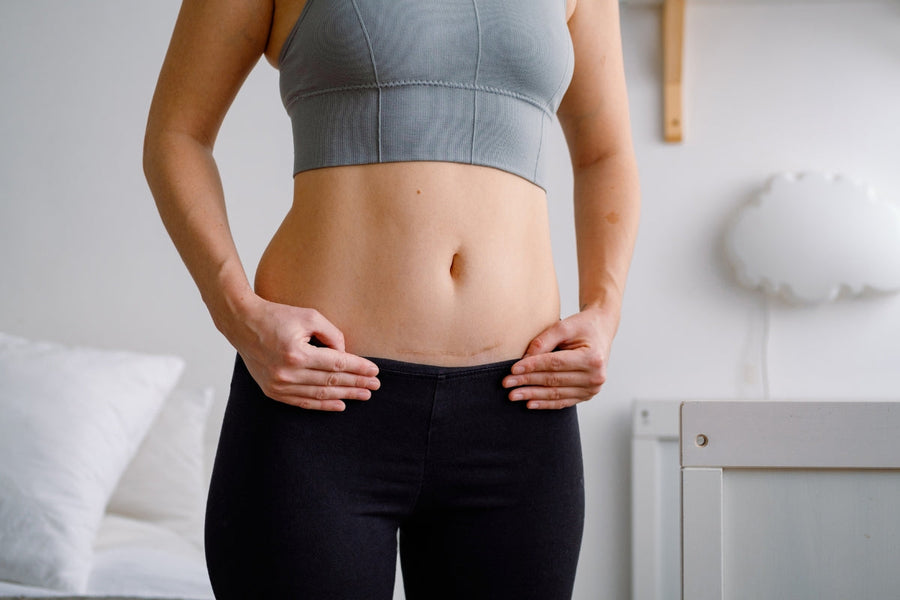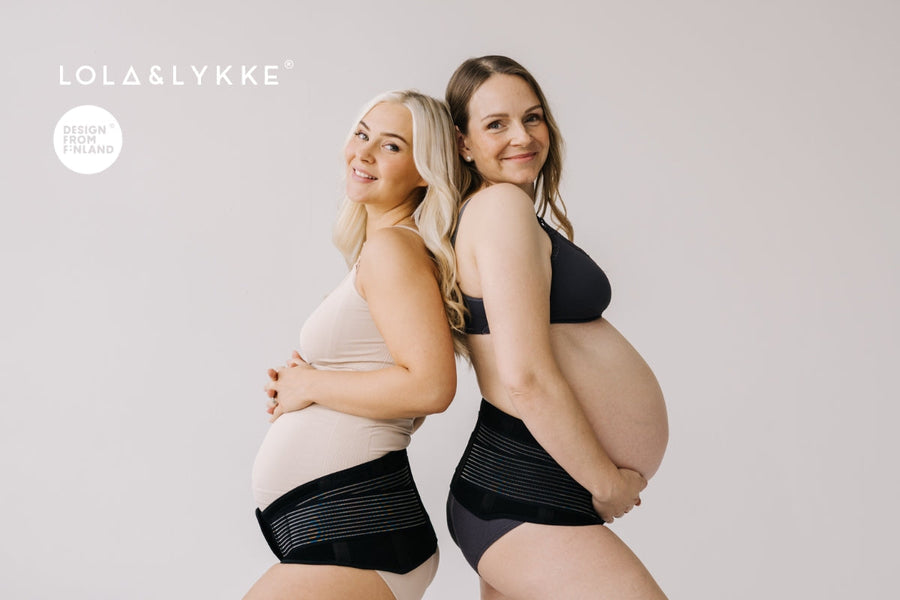Moving after a C-section is no walk in the park, at least not at first. Wondering “When can I start bending after a C-section?”, when even the smallest of movements feel the hardest, can be daunting in the beginning.
Rest assured, every mother’s C-section recovery is a personal journey, and you can heal safely and slowly with the right support to gradually regain your mobility. Whether that’s using a core support band or relying on the help of others, listening to your body is the first step on the road to recovery after a C-section.
Why Bending After a C-section Needs Special Care
Although we talk about C-sections casually because they happen every day, it’s still major surgery. Recovery after a C-section is a slow and gentle process to give your core muscles and fascia time to heal.
After the procedure, the small incision along the top of your bikini line is stitched back together. Bending too soon after a C-section can interrupt the healing process, which could strain your C-section scar or deepen a C-section overhang.
There is no “bouncing back” after a C-section. Even after a vaginal birth, it can take up to a year for your body to fully heal after pregnancy and labour. Rushing back to your daily routine will do more harm than good, and you will need to depend on the help of others to support your recovery.
When Can I Start Bending After a C-section?
You may be able to start gentle bending around 2–3 weeks, depending on how your C-section scar is healing and your comfort level.
Twisting and deeper bending usually happen later in your recovery after a C-section, often around 6–8 weeks. This is also when many mums are cleared for light exercise by their healthcare provider, making it a good milestone to measure your progress against.
If you feel or notice any of these signs, you’re probably not ready to start bending after a C-section just yet.
-
Your C-section scar is sore or swollen
-
You cannot lift anything heavier than your baby
-
Your C-section scar shows signs of infection or bleeding
-
You need medication for pain management
-
Your doctor hasn’t given you the “green light” to resume light exercises
It’s only when you think really hard about not bending your core muscles that you realise just how often we do it every day! Simple activities like housework or walking involve bending and twisting to a degree.
Even driving after a C-section falls under the category of core movement, as turning the steering wheel, checking blind spots, or reaching for controls all require subtle bending and twisting that can put pressure on your healing C-section scar.
Before you start any activities, you should consult with your doctor beforehand to rule out any concerns or complications with your C-section recovery.
The First Three Weeks
Your first milestone after your baby is born will be sitting up comfortably and holding your baby. After the first 24 hours, you might manage to eat, drink, stand, and walk, but for some, it can take a little longer. You can expect to stay in the hospital for 2-4 days following a C-section delivery.
After 2 weeks postpartum, the pain around your incision will be your guide. Even the thought of bending over will likely be unappealing during this time.
3-6 weeks postpartum after C-section
As each birth and woman is unique, there’s no hard-and-fast rule for how long you should wait to start bending. So, when can I start bending after a C-section? Even if you feel ok, it’s super important to get the OK from your healthcare professional before you start bending or resume any physical activity during your recovery after a C-section.
When you have had your first check-up (around 6 weeks postpartum), your doctor or midwife will say if and when it is safe to start exercising and driving after a C-section. Be mindful to take movements slowly and carefully so as not to complicate your C-section recovery or worsen your C-section pouch.
C-section recovery after 6 weeks
As you continue to recover from your cesarean birth, you’ll gradually feel stronger and more confident about bending and getting back to your normal daily routine.
It’s common to experience back pain after a C-section or discomfort around your C-section scar, even 8 weeks after cesarean delivery. However, this discomfort should gradually decrease over time, and if it’s sticking around or increasing, put a call in to your healthcare provider.
Some mums use a postpartum support belt to help manage back pain and support their core muscles as they move throughout the day. You can start wearing a postpartum support belt from day one after birth.
Tips for Safe, Gentle Bending During C-section Recovery
Your body after a C-section feels as together as your toddler carrying an open cup of water. It’s a subtle art to keep it all in! But there are safe techniques to keep you feeling “together” and mobile so you don’t feel restricted throughout your C-section recovery in the early days.
1. Use the “Hip Hinge” Technique
Instead of bending from your waist, bend from your hips. As you do this, keep your spine straight to reduce crunching.
2. Support Your Core Before Moving
Engage your lower belly muscles (like you’re hugging your baby from the inside). Wearing a postpartum support band can help with this if you find it difficult at first.
3. Hold Your Scar When Sneezing, Coughing, or Bending
Remember sneezing without having to cross your legs? Well, the same concept applies here! Gently holding your C-section scar when coughing, sneezing, or bending can alleviate pressure on your core and a tugging sensation.
4. Avoid lifting heavy items while bending
You might think this one is easy, but babies have a lot of stuff. Think twice before you…
-
Bend over to grab the changing bag
-
Transfer your baby whilst they are in their car seat to and from the car
-
Lift the stroller out of the house
-
Reach for heavier objects to the side of you or behind you
-
Do household chores such as unloading the dishwasher
How a Postpartum Support Band Can Help You Bend More Comfortably
Following C-section surgery, your body feels tender and “put back together”. Even simple movements taken too quickly or without thought can set you back. A popular maternity essential for mums in recovery after a C-section is a postpartum support band.
A postpartum support band is worn like a belt around your core, protecting your C-section scar as it heals, but also supporting your core muscles to help you stay mobile.
Mum of twins, Ruchi, tried Lola&Lykke’s Core Restore Postpartum Support Band, and shared:
“I've tried some post C-section belly bands, but this core restore support band is the best that I've tried on yet. I love that it is super soft and super-elastic that perfectly sits over the abdominal area.”
A postpartum support belt can also help with…
-
Providing gentle compression and core stabilisation
-
Reduces the pull on the C-section scar during movement
-
Supports your posture and stops you from overextending
-
Many mums say it gives them “confidence to move again”, especially in the first 6 weeks
-
Suitable postpartum for both vaginal and C-section births
Need a belly wrap that feels like a hug and supports like a boss?
Explore the Lola&Lykke Postpartum Band
Other Movements to Ease Back Into Slowly
Focusing on how you move your body safely is a big part of recovery after a C-section. You may also be experiencing back pain after a C-section, so changing how you move can alleviate some discomfort.
Log roll technique after C-section
This technique is particularly helpful for getting in and out of bed to reduce any strain on your C-section pouch whilst it heals. To get into bed, sit on the side of the bed and use your arms to lower yourself onto your side. As you lower yourself onto the bed, bend your knees and align them with your hips. From there, you can slowly roll yourself onto the bed. To get out of bed, simply reverse this process.
Driving after a C-section
Just getting in and out of the car is one thing; driving is another. You might learn this when you return home from the hospital! You won’t be safe to drive for at least 6 weeks post-surgery, and you can only resume driving after a C-section once your doctor has deemed you fit to do so.
Even when you’re ready to drive again, be mindful when turning and twisting your body in the seat. If you cannot comfortably turn to check your blind spots, ask yourself if you’re really ready to drive again.
Exercises for your core muscles
Exercises and drills that “crunch” and bend your core can cause more damage than good for C-section recovery. It also worsens the appearance of a C-section overhang, which is where your tummy hangs over your C-section scar. Instead, try gentle stretches that encourage mobility and light exercises such as walking or yoga poses.
Learn how to start The Best Diastasis Recti Exercises and How to Strengthen and Relax Your Pelvic Floor
Lifting after C-section
If what you’re lifting is heavier than your baby, the rule of thumb says don’t lift it. Especially if it involves you bending and lifting something heavy because your postpartum body isn’t ready for this yet, so soon after surgery.
Following sign off from your doctor at 6-8 weeks postpartum, you might be ready to engage in light lifting. However, remember to use these tips to lift and bend safely:
-
Squat using your legs to lower yourself down slowly
-
Use something stable nearby for support (e.g. furniture or another person)
-
Don’t over carry or lift to make fewer trips back and forth
-
Ask for advice from a maternal physiotherapist for support
Support Your Body, Trust Your Timing
Recovery after C-section isn’t a race. There’s no gold medal for doing it quickly to get back on your feet. You will do yourself more favours in the long run to take your C-section recovery slowly, day by day.
Healing slowly and looking after yourself postpartum means your core will be stronger long-term, you will have less risk of C-section overhang, and a smoother return to daily life. Take the time to recover safely and seek support when you need it so you can bend, move, and feel strong again.



